warning SKODA FABIA 2006 2.G / 5J Owners Manual
[x] Cancel search | Manufacturer: SKODA, Model Year: 2006, Model line: FABIA, Model: SKODA FABIA 2006 2.G / 5JPages: 258, PDF Size: 44.86 MB
Page 135 of 258
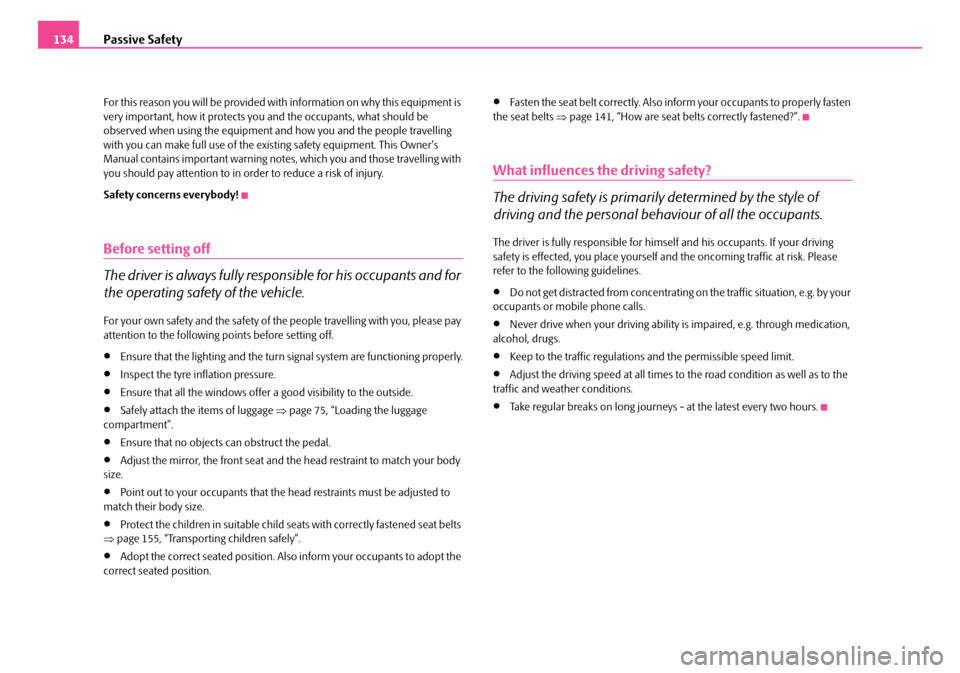
Passive Safety134
For this reason you will be provided with information on why this equipment is very important, how it protects you and the occupants, what should be observed when using the equipment and how you and the people travelling with you can make full use of the exis ting safety equipment. This Owner's Manual contains important warning notes, which you and those travelling with you should pay attention to in order to reduce a risk of injury.
Safety concerns everybody!
Before setting off
The driver is always fully responsible for his occupants and for
the operating safety of the vehicle.
For your own safety and the safety of the people travelling with you, please pay attention to the following points before setting off.
•Ensure that the lighting and the turn signal system are functioning properly.
•Inspect the tyre inflation pressure.
•Ensure that all the windows offer a good visibility to the outside.
•Safely attach the items of luggage ⇒page 75, “Loading the luggage compartment”.
•Ensure that no objects can obstruct the pedal.
•Adjust the mirror, the front seat and the head restraint to match your body size.
•Point out to your occupants that the head restraints must be adjusted to match their body size.
•Protect the children in suitable child se ats with correctly fastened seat belts ⇒ page 155, “Transporting children safely”.
•Adopt the correct seated position. Also inform your occupants to adopt the correct seated position.
•Fasten the seat belt correctly. Also inform your occupants to properly fasten the seat belts ⇒page 141, “How are seat belts correctly fastened?”.
What influences the driving safety?
The driving safety is primaril y determined by the style of
driving and the personal behaviour of all the occupants.
The driver is fully responsible for hims elf and his occupants. If your driving safety is effected, you place yourself an d the oncoming traffic at risk. Please refer to the following guidelines.
•Do not get distracted from concentrating on the traffic situation, e.g. by your occupants or mobile phone calls.
•Never drive when your driving ability is impaired, e.g. through medication, alcohol, drugs.
•Keep to the traffic regulations and the permissible speed limit.
•Adjust the driving speed at all times to the road condition as well as to the traffic and weather conditions.
•Take regular breaks on long journe ys - at the latest every two hours.
NKO A05Fabia 20.book Page 134 Tuesday, September 26, 2006 8:38 AM
Page 136 of 258

Passive Safety135
Using the systemSafetyDriving TipsGeneral MaintenanceBreakdown assistanceTechnical Data
Correct seated position
Correct seated position for the driver
Correct seated position for the driver is important for safe and
relaxed driving.
For your own safety and to reduce the risk of injury in the event of an accident, we recommend the following setting.
•Adjust the steering wheel so that th e distance between the steering wheel and your chest is at least 25 cm ⇒fig. 104.
•Position the driver seat in the forward/back direction so that you are able to press the pedals with your legs at a slight angle .
•Adjust the backrest so that you are ab le to reach the highest point of the steering wheel with your arms at a slight angle.
•Adjust the head restraint so that the top edge of the head restraint is at the same level as the upper part of your head ⇒fig. 105.
•Fasten the seat belt correctly ⇒page 141, “How are seat belts correctly fastened?”.
Driver seat adjustment ⇒page 70, “Adjusting the front seats”.
WARNING
•The front seats and the head restraints must always be adjusted to match the body size of the seat occupant as well as the seat belts must
Fig. 104 The correct distance of the driver from the steering wheel
Fig. 105 The correct head restraint adjust-ment for the driver
NKO A05Fabia 20.book Page 135 Tuesday, September 26, 2006 8:38 AM
Page 137 of 258
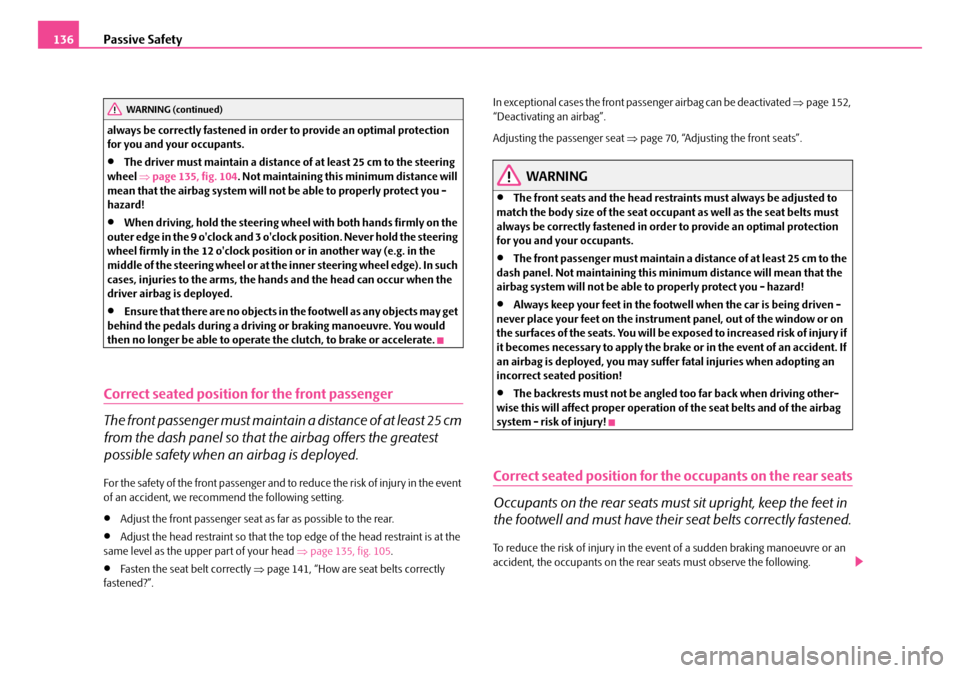
Passive Safety136
always be correctly fastened in order to provide an optimal protection for you and your occupants.
•The driver must maintain a distance of at least 25 cm to the steering wheel ⇒page 135, fig. 104. Not maintaining this minimum distance will mean that the airbag system will not be able to properly protect you - hazard!
•When driving, hold the steering wheel with both hands firmly on the outer edge in the 9 o'clock and 3 o'cl ock position. Never hold the steering wheel firmly in the 12 o'clock position or in another way (e.g. in the middle of the steering wheel or at the inner steering wheel edge). In such cases, injuries to the arms, the hands and the head can occur when the driver airbag is deployed.
•Ensure that there are no objects in the footwell as any objects may get behind the pedals during a driving or braking manoeuvre. You would then no longer be able to operate the clutch, to brake or accelerate.
Correct seated position for the front passenger
The front passenger must maintain a distance of at least 25 cm
from the dash panel so that the airbag offers the greatest
possible safety when an airbag is deployed.
For the safety of the front passenger and to reduce the risk of injury in the event of an accident, we recommend the following setting.
•Adjust the front passenger seat as far as possible to the rear.
•Adjust the head restraint so that the top edge of the head restraint is at the same level as the upper part of your head ⇒page 135, fig. 105.
•Fasten the seat belt correctly ⇒page 141, “How are seat belts correctly fastened?”.
In exceptional cases the front pass enger airbag can be deactivated ⇒page 152, “Deactivating an airbag”.
Adjusting the passenger seat ⇒page 70, “Adjusting the front seats”.
WARNING
•The front seats and the head restraints must always be adjusted to match the body size of the seat occupant as well as the seat belts must always be correctly fastened in order to provide an optimal protection for you and your occupants.
•The front passenger must maintain a distance of at least 25 cm to the dash panel. Not maintaining this minimum distance will mean that the airbag system will not be able to properly protect you - hazard!
•Always keep your feet in the footwe ll when the car is being driven - never place your feet on the instrument panel, out of the window or on the surfaces of the seats. You will be exposed to increased risk of injury if it becomes necessary to apply the brake or in the event of an accident. If an airbag is deployed, you may suffer fatal injuries when adopting an incorrect seated position!
•The backrests must not be angled too far back when driving other- wise this will affect proper operation of the seat belts and of the airbag system - risk of injury!
Correct seated position for the occupants on the rear seats
Occupants on the rear seats must sit upright, keep the feet in
the footwell and must have their seat belts correctly fastened.
To reduce the risk of injury in the event of a sudden braking manoeuvre or an accident, the occupants on the rear seats must observe the following.
WARNING (continued)
NKO A05Fabia 20.book Page 136 Tuesday, September 26, 2006 8:38 AM
Page 138 of 258

Passive Safety137
Using the systemSafetyDriving TipsGeneral MaintenanceBreakdown assistanceTechnical Data
•Adjust the head restraints so that the top edge of the head restraints are at the same level as the upper part of your head ⇒page 135, fig. 105.
•Fasten the seat belt correctly ⇒page 141, “How are seat belts correctly fastened?”.
•If you are transporting ⇒page 155, “Transporting children safely” children in the vehicle, plea se use a suitable child restraint system.
WARNING
•The head restraints must always be adjusted to match the body size, in order to offer an optimal protection for you and your occupants.
•Always keep your feet in the footwell when the car is being driven - never put your feet out of the window or on the surfaces of the seats. You will be exposed to increased risk of injury if it becomes necessary to apply the brake or in the event of an accident. If the head airbag* is deployed and when adopting an in correct seated position, you are exposing yourself to an increased risk of injury and in the event of an accident you may suffer fatal injuries!
•If the occupants on the rear seats are not sitting upright, the risk of injury is increased due to inco rrect routing of the seat belt.
Examples of an incorrect seated position
An incorrect seated position can lead to severe injuries or
death for the occupants.
Seat belts offer their optimum protection on ly if the webbing of the seat belts is properly routed. Incorrect seated positi ons considerably reduce the protective functions of the seat belts and therefore increase the risk of injury due to an incorrect routing of the seat belt. The driver is fully responsible for himself and his occupants, in particular for the ch ildren. Do not permit an occupant to adopt an incorrect seated position when the car is moving.
The following list contains the examples of seated positions which are dangerous for the occupants. This list is not complete, however we would like you to get interested in this subject.
Therefore, while the car is moving never:
•stand up in the vehicle,
•stand up on the seats,
•kneel onto the seats,
•tilt the backrest fully to the back,
•lean against the dash panel,
•lie on the rear seats,
•only sit on the front area of the seat,
•sit to the side,
•lean out of the window,
•put the feet out of the window,
•put the feet on the dash panel,
•put the feet on the seat upholstery,
•occupy the footwell,
•have the seat belt not fastened,
•occupy the luggage compartment.
WARNING
•If the occupant adopts an incorrect seated position, he is exposed to life-threatening injuries, in case he is hit by a deployed airbag.
•Before setting off, please adopt the correct seated position and do not change this seated position while th e car is moving. Also advise your occupants to adopt the correct seated position and not to change this seated position while the car is moving.
NKO A05Fabia 20.book Page 137 Tuesday, September 26, 2006 8:38 AM
Page 139 of 258
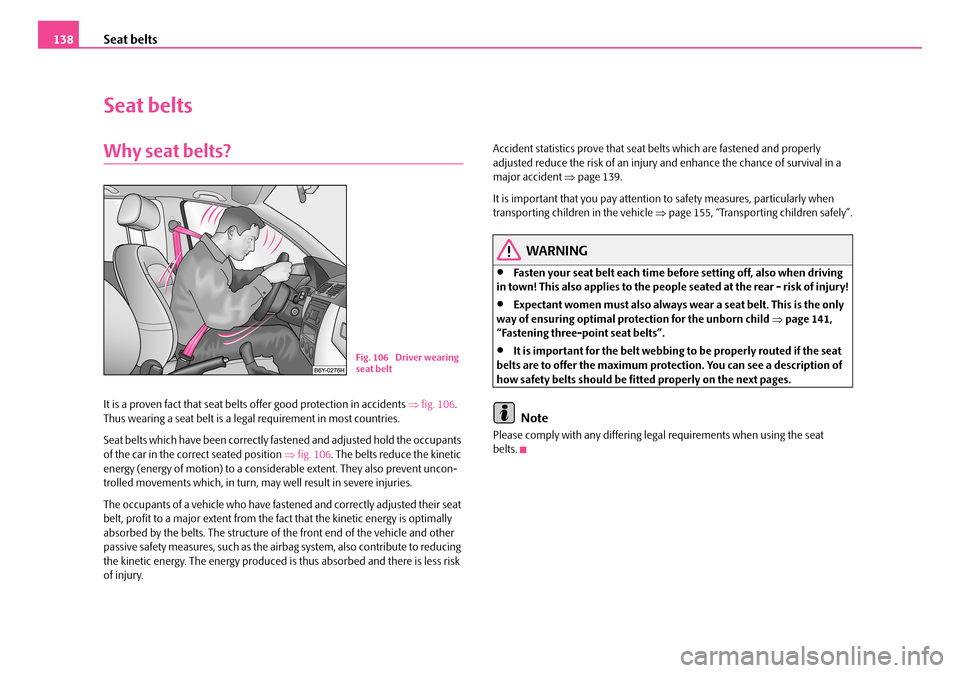
Seat belts138
Seat belts
Why seat belts?
It is a proven fact that seat belts offer good protection in accidents ⇒fig. 106. Thus wearing a seat belt is a le gal requirement in most countries.
Seat belts which have been correctly fa stened and adjusted hold the occupants of the car in the correct seated position ⇒fig. 106. The belts reduce the kinetic energy (energy of motion) to a considerable extent. They also prevent uncon- trolled movements which, in turn, may well result in severe injuries.
The occupants of a vehicle who have fast ened and correctly adjusted their seat belt, profit to a major extent from the fa ct that the kinetic energy is optimally absorbed by the belts. The structure of the front end of the vehicle and other passive safety measures, such as the airb ag system, also contribute to reducing the kinetic energy. The energy produced is thus absorbed and there is less risk of injury.
Accident statistics prove that seat belts which are fastened and properly adjusted reduce the risk of an injury and enhance the chance of survival in a major accident ⇒page 139.
It is important that you pay attention to safety measures, particularly when transporting children in the vehicle ⇒page 155, “Transporting children safely”.
WARNING
•Fasten your seat belt each time before setting off, also when driving in town! This also applies to the people seated at the rear - risk of injury!
•Expectant women must also always we ar a seat belt. This is the only way of ensuring optimal protection for the unborn child ⇒page 141, “Fastening three-point seat belts”.
•It is important for the belt webbing to be properly routed if the seat belts are to offer the maximum protec tion. You can see a description of how safety belts should be fitted properly on the next pages.
Note
Please comply with any differing legal requirements when using the seat belts.
Fig. 106 Driv er wearing seat belt
NKO A05Fabia 20.book Page 138 Tuesday, September 26, 2006 8:38 AM
Page 141 of 258
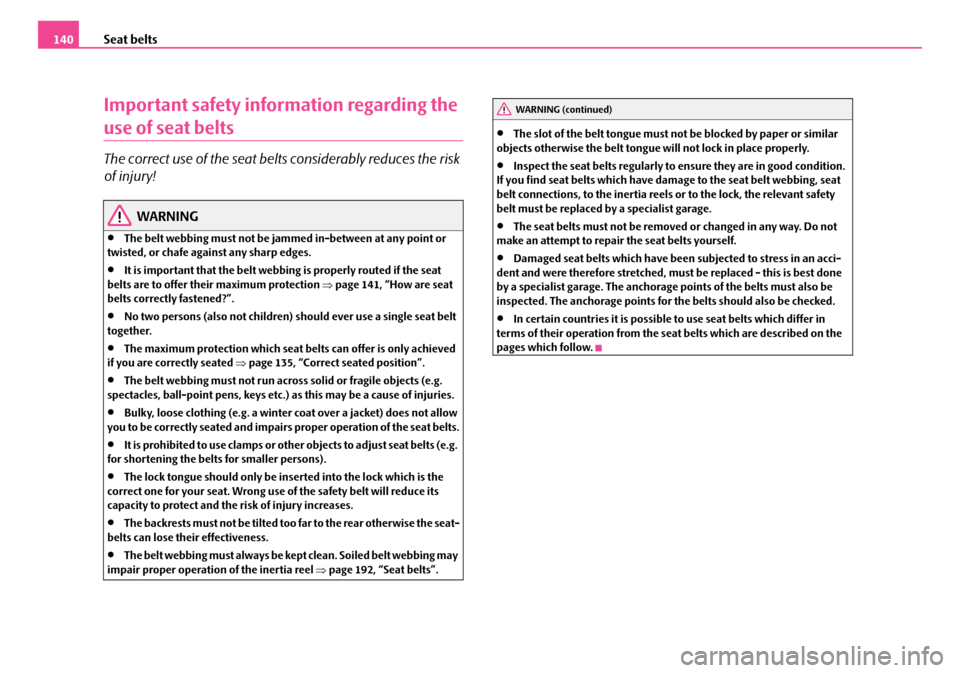
Seat belts140
Important safety information regarding the
use of seat belts
The correct use of the seat belts considerably reduces the risk
of injury!
WARNING
•The belt webbing must not be ja mmed in-between at any point or twisted, or chafe against any sharp edges.
•It is important that the belt webbing is properly routed if the seat belts are to offer their maximum protection ⇒page 141, “How are seat belts correctly fastened?”.
•No two persons (also not children) should ever use a single seat belt together.
•The maximum protection which seat belts can offer is only achieved if you are correctly seated ⇒page 135, “Correct seated position”.
•The belt webbing must not run across solid or fragile objects (e.g. spectacles, ball-point pens , keys etc.) as this may be a cause of injuries.
•Bulky, loose clothing (e.g. a winter coat over a jacket) does not allow you to be correctly seated and impairs proper operation of the seat belts.
•It is prohibited to use clamps or other objects to adjust seat belts (e.g. for shortening the belts for smaller persons).
•The lock tongue should only be inserted into the lock which is the correct one for your seat. Wrong use of the safety belt will reduce its capacity to protect and the risk of injury increases.
•The backrests must not be tilted too far to the rear otherwise the seat- belts can lose their effectiveness.
•The belt webbing must always be ke pt clean. Soiled belt webbing may impair proper operation of the inertia reel ⇒page 192, “Seat belts”.
•The slot of the belt tongue must not be blocked by paper or similar objects otherwise the belt tongue will not lock in place properly.
•Inspect the seat belts r egularly to ensure they are in good condition. If you find seat belts which have damage to the seat belt webbing, seat belt connections, to the inertia reels or to the lock, the relevant safety belt must be replaced by a specialist garage.
•The seat belts must not be removed or changed in any way. Do not make an attempt to repair the seat belts yourself.
•Damaged seat belts which have been subjected to stress in an acci- dent and were therefore stretched, must be replaced - this is best done by a specialist garage. The anchorage points of the belts must also be inspected. The anchorage points for the belts should also be checked.
•In certain countries it is possible to use seat belts which differ in terms of their operation from the seat belts which are described on the pages which follow.
WARNING (continued)
NKO A05Fabia 20.book Page 140 Tuesday, September 26, 2006 8:38 AM
Page 142 of 258

Seat belts141
Using the systemSafetyDriving TipsGeneral MaintenanceBreakdown assistanceTechnical Data
How are seat belts correctly fastened?
Fastening three-point seat belts
Fasten your seat belt before starting!
– Correctly adjust the seat and the head restraint before fastening
your seat belt ⇒page 135, “Correct seated position”.
– Slowly pull the belt webbing at th e tongue of the lock over your
chest and pelvis ⇒.
– Insert the tongue of the lock into the seat belt buckle belonging to
the seat until it is heard to lock in place.
– Pull on the belt to check that it has also reliably engaged in the lock.
Each three-point seat belt is equipped with an inertia reel. This inertia reel offers you complete freedom of movement if the belt is unreeled slowly. If the brakes are applied suddenly, the inertia reel will block. It also blocks the belts when the car accelerates, when driving downhill and when cornering.
Expectant mothers must also wear the seat belt ⇒.
WARNING
•The shoulder part of the seat belt must never run across your neck but must run approximately over th e middle of the shoulder and fit snugly against the chest. The lap part of the belt must run across the hip and must never be routed across the stomach. It must always fit snugly ⇒ fig. 109. Adjust the belt webbing as required.
•The lap part of the belt should be positioned as low as possible at the pelvis of an expectant mother in or der to avoid exerting any pressure on the lower abdomen.
•Always ensure that the webbing of the seat belts is properly routed. Seat belts which are not correctly adjusted can themselves cause injuries even in minor accidents.
•A seat belt which is hanging too loose can result in injuries as your body is moved forward by the kineti c energy produced in an accident and is then suddenly held firm by the belt.
Fig. 109 Routing of webbing over the shoul-ders and the lap belt
Fig. 110 Routing of belt webbing for an expectant mother
NKO A05Fabia 20.book Page 141 Tuesday, September 26, 2006 8:38 AM
Page 143 of 258
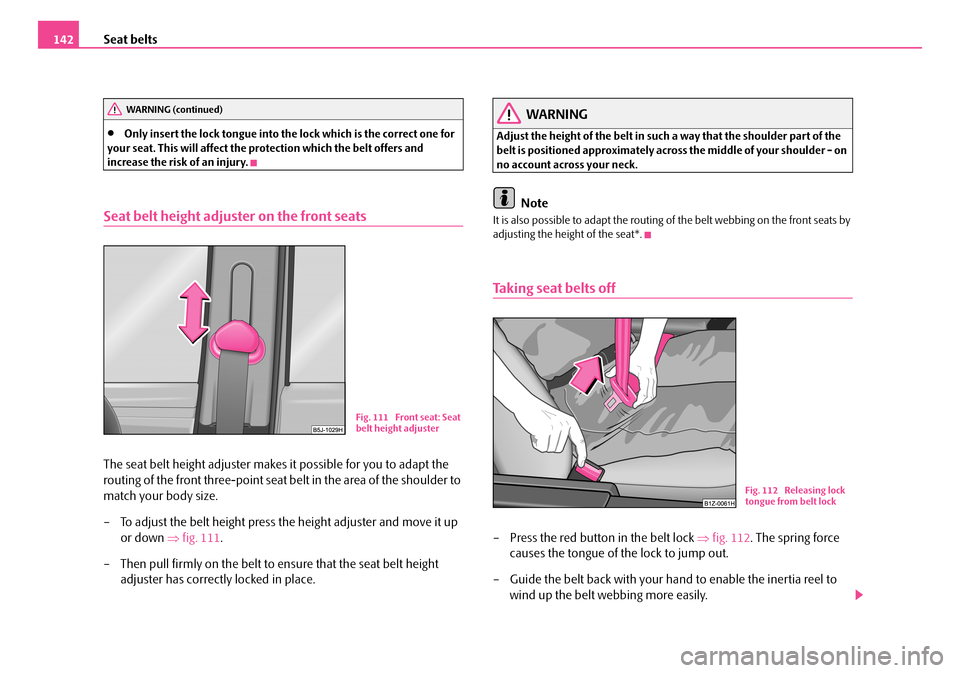
Seat belts142
•Only insert the lock tongue into the lock which is the correct one for your seat. This will affect the protection which the belt offers and increase the risk of an injury.
Seat belt height adjuster on the front seats
The seat belt height adjuster make s it possible for you to adapt the
routing of the front three-point seat belt in the area of the shoulder to
match your body size.
– To adjust the belt height press the height adjuster and move it up
or down ⇒fig. 111.
– Then pull firmly on the belt to en sure that the seat belt height
adjuster has correctly locked in place.
WARNING
Adjust the height of the belt in such a way that the shoulder part of the belt is positioned approximately acro ss the middle of your shoulder - on no account across your neck.
Note
It is also possible to adapt the routing of the belt webbing on the front seats by adjusting the height of the seat*.
Taking seat belts off
– Press the red button in the belt lock ⇒fig. 112. The spring force
causes the tongue of the lock to jump out.
– Guide the belt back with your ha nd to enable the inertia reel to
wind up the belt webbing more easily.
WARNING (continued)
Fig. 111 Front seat: Seat belt height adjuster
Fig. 112 Releasing lock tongue from belt lock
NKO A05Fabia 20.book Page 142 Tuesday, September 26, 2006 8:38 AM
Page 144 of 258
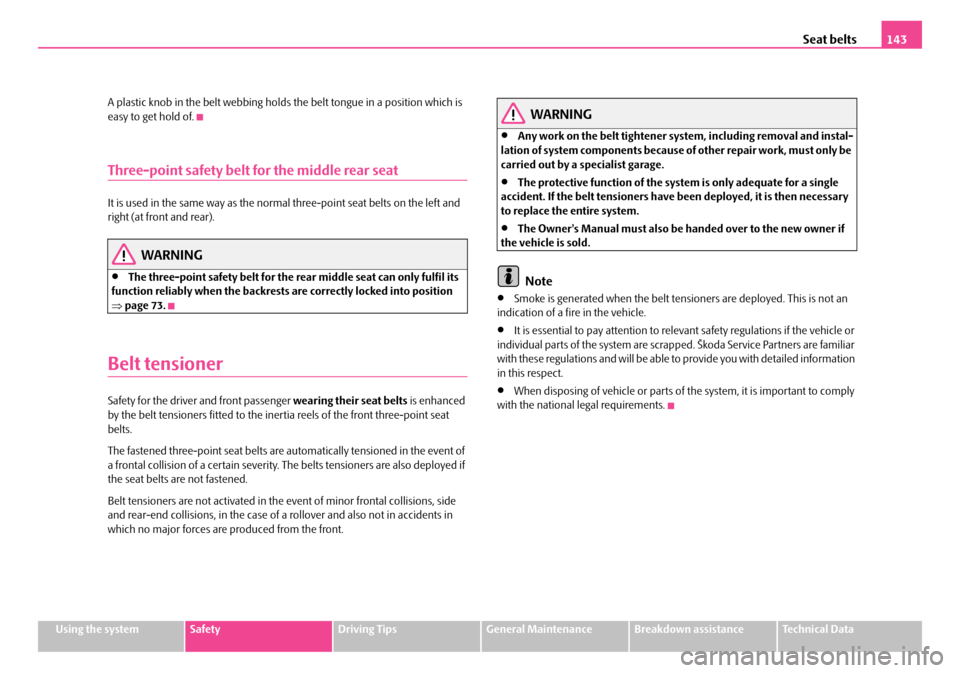
Seat belts143
Using the systemSafetyDriving TipsGeneral MaintenanceBreakdown assistanceTechnical Data
A plastic knob in the belt webbing holds the belt tongue in a position which is easy to get hold of.
Three-point safety belt for the middle rear seat
It is used in the same way as the normal three-point seat belts on the left and right (at front and rear).
WARNING
•The three-point safety belt for the rear middle seat can only fulfil its function reliably when the backrests are correctly locked into position ⇒ page 73.
Belt tensioner
Safety for the driver and front passenger wearing their seat belts is enhanced by the belt tensioners fitted to the inertia reels of the front three-point seat belts.
The fastened three-point seat belts are automatically tensioned in the event of a frontal collision of a certain severity. The belts tensioners are also deployed if the seat belts are not fastened.
Belt tensioners are not activated in the event of minor frontal collisions, side and rear-end collisions, in the case of a rollover and also not in accidents in which no major forces are produced from the front.
WARNING
•Any work on the belt tightener sy stem, including removal and instal- lation of system components because of other repair work, must only be carried out by a specialist garage.
•The protective function of the system is only adequate for a single accident. If the belt tensioners have been deployed, it is then necessary to replace the entire system.
•The Owner's Manual must also be handed over to the new owner if the vehicle is sold.
Note
•Smoke is generated when the belt tensioners are deployed. This is not an indication of a fire in the vehicle.
•It is essential to pay attention to releva nt safety regulations if the vehicle or individual parts of the system are scrapped. Škoda Service Partners are familiar with these regulations and will be able to provide you with detailed information in this respect.
•When disposing of vehicle or parts of the system, it is important to comply with the national legal requirements.
NKO A05Fabia 20.book Page 143 Tuesday, September 26, 2006 8:38 AM
Page 145 of 258
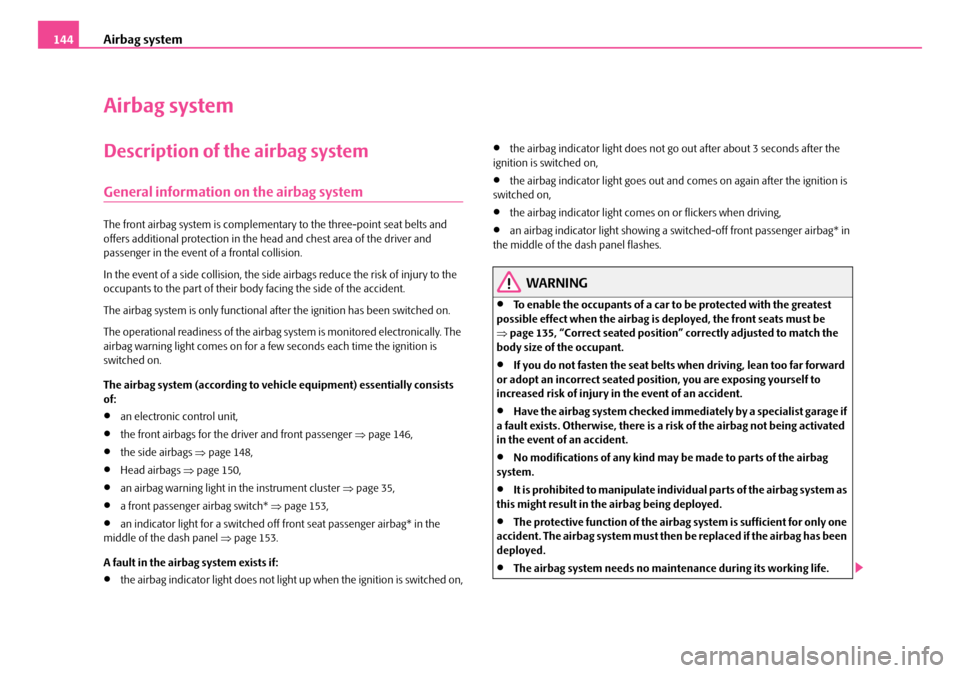
Airbag system144
Airbag system
Description of the airbag system
General information on the airbag system
The front airbag system is complementary to the three-point seat belts and offers additional protection in the head and chest area of the driver and passenger in the event of a frontal collision.
In the event of a side collision, the side ai rbags reduce the risk of injury to the occupants to the part of their body facing the side of the accident.
The airbag system is only functional after the ignition has been switched on.
The operational readiness of the airbag system is monitored electronically. The airbag warning light comes on for a fe w seconds each time the ignition is switched on.
The airbag system (according to vehi cle equipment) essentially consists of:
•an electronic control unit,
•the front airbags for the driver and front passenger ⇒page 146,
•the side airbags ⇒page 148,
•Head airbags ⇒page 150,
•an airbag warning light in the instrument cluster ⇒page 35,
•a front passenger airbag switch* ⇒page 153,
•an indicator light for a switched off front seat passenger airbag* in the middle of the dash panel ⇒page 153.
A fault in the airbag system exists if:
•the airbag indicator light does not ligh t up when the ignition is switched on,
•the airbag indicator light does not go out after about 3 seconds after the ignition is switched on,
•the airbag indicator light goes out and comes on again after the ignition is switched on,
•the airbag indicator light comes on or flickers when driving,
•an airbag indicator light showing a sw itched-off front passenger airbag* in the middle of the dash panel flashes.
WARNING
•To enable the occupants of a car to be protected with the greatest possible effect when the airbag is deployed, the front seats must be ⇒ page 135, “Correct seated position” correctly adjusted to match the body size of the occupant.
•If you do not fasten the seat belts when driving, lean too far forward or adopt an incorrect seated position, you are exposing yourself to increased risk of injury in the event of an accident.
•Have the airbag system checked imme diately by a specialist garage if a fault exists. Otherwise, there is a risk of the airbag not being activated in the event of an accident.
•No modifications of any kind may be made to parts of the airbag system.
•It is prohibited to manipulate individual parts of the airbag system as this might result in the airbag being deployed.
•The protective function of the airbag system is sufficient for only one accident. The airbag system must then be replaced if the airbag has been deployed.
•The airbag system needs no main tenance during its working life.
NKO A05Fabia 20.book Page 144 Tuesday, September 26, 2006 8:38 AM